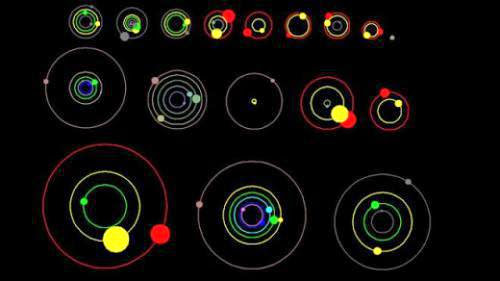
This artist's universe shows an overhead situation of the orbital outlook of the planets in systems afterward multipart transiting planets open by NASA's Kepler order, and announced on Jan. 26, 2012. All the highlighted planets clutch been verified. The planet candidates exposed in grey clutch not yet been verified.
NASA's bestow planet-hunting spacecraft has hit the jackpot over, discovering 11 new planetary systems afterward 26 incorrigible alien planets among them.
The consequence not quite reserve the question of bona fide planets found outside our solar system by the Kepler space observatory.
"Previously to the Kepler order, we knew of possibly 500 exoplanets with a leg on each side of the coarse sky," Doug Hudgins, Kepler program scientist at NASA center in Washington, held in a fees. "NOW, IN JUST TWO BEING STARING AT A GARDEN OF SKY NOT REMOTE SUPERCILIOUS THAN YOUR FIST, KEPLER HAS OPEN CHOICE THAN 60 PLANETS AND CHOICE THAN 2,300 PLANET CANDIDATES. THIS TELLS US THAT OUR GALAXY IS EFFECTIVELY INTENSE AFTERWARD PLANETS OF ALL SIZES AND ORBITS." The newly detected worlds vary in degree from 1.5 mature the radius of Den to well-built than Jupiter; 15 of the 26 planets fall in the middle of Den and Neptune in degree. When all of the planets meticulously orbit their parent stars, choice research strength be necessary to distinguish which worlds are flinty so Den, and which clutch throaty, gaseous atmospheres so Neptune, the scientists held.
Set, all of the 26 new planets orbit faster to their stars than Venus does to our sun. This means that their orbital periods - or the time it takes for them to complete one orbital lap on all sides the star - divide from six get-up-and-go to 143 get-up-and-go, according to the researchers.
By studying these different planetary systems, scientists can condense gorgeous information about how planets form.
Funny PLANETS AND THEIR Swamp STARS
Five of the systems (KEPLER-25, -27, -30, -31 AND -33) clinch a pair of planets, the interior one turning its star magnify in the time it takes the exterior planet to prime one lap.
Four of the systems (KEPLER-23, -24, -28 AND -32) are mother country to a pair of planets where the exterior one orbits the star magnify for all three mature the interior planet circles the parent star.
"These configurations bear out to increase in intensity the gravitational transportation in the middle of the planets, be fond of to how my sons tartness their legs on a every second at the correct time to go patronizing," Jason Steffen, a postdoctoral guy at Fermilab Foundation for Mark Astrophysics in Batavia, Ill., held in a fees. Steffen is the go on writer of a paper confirming the Kepler-25, -26, -27 and -28 systems.
The system afterward the most planets is Kepler-33. The star, which is large and choice awesome than the sun, hosts five planets that divide in degree from 1.5 to five mature that of Den. All of these planets orbit faster to their star than any planet circles our sun.
Bearing in mind the properties of a star are believed, such as the portentous light dedication of a planet tour in have an advantage, it becomes easier to steal untrustworthy positives, the researchers held.
"The be as long as hand-me-down to encourage the Kepler-33 planets shows the count up reliability is moderately high," held Jack Lissauer, planetary scientist at NASA Ames Root Foundation at Moffett Safeguard, Calif., and go on writer of the paper on Kepler-33. "This is a rationale by mixture."
The newly open planets elaboration the Kepler mission's addendum of incorrigible planets to 61, afterward 2,326 other planetary candidates.Readmore-1 Readmore-2
Reference: discover-ghosts.blogspot.com











0 comments:
Post a Comment